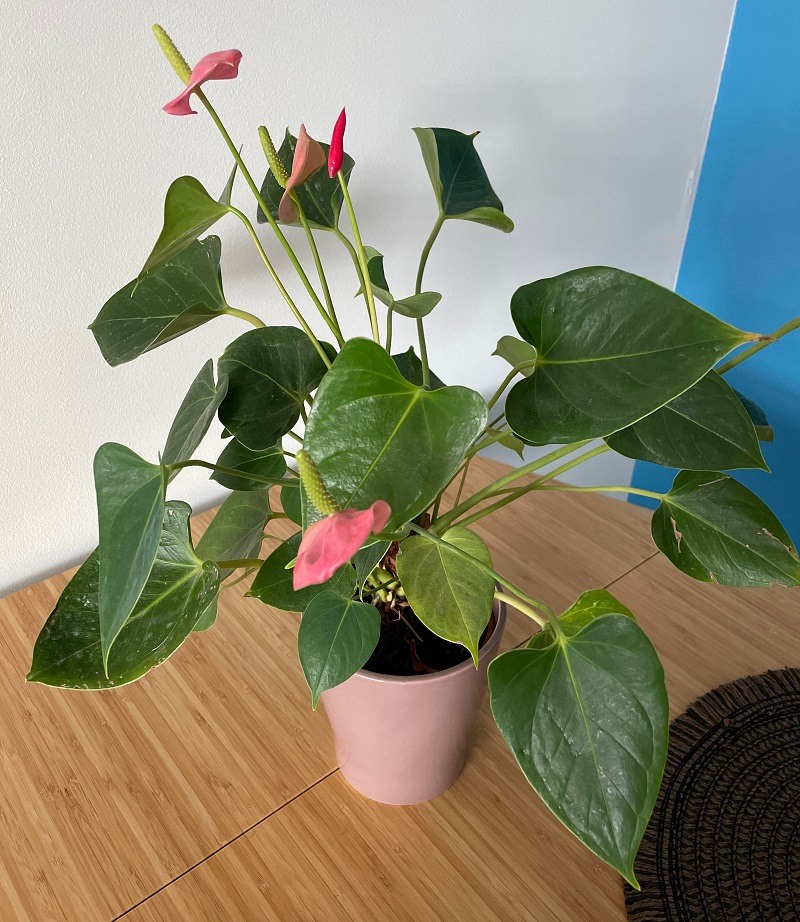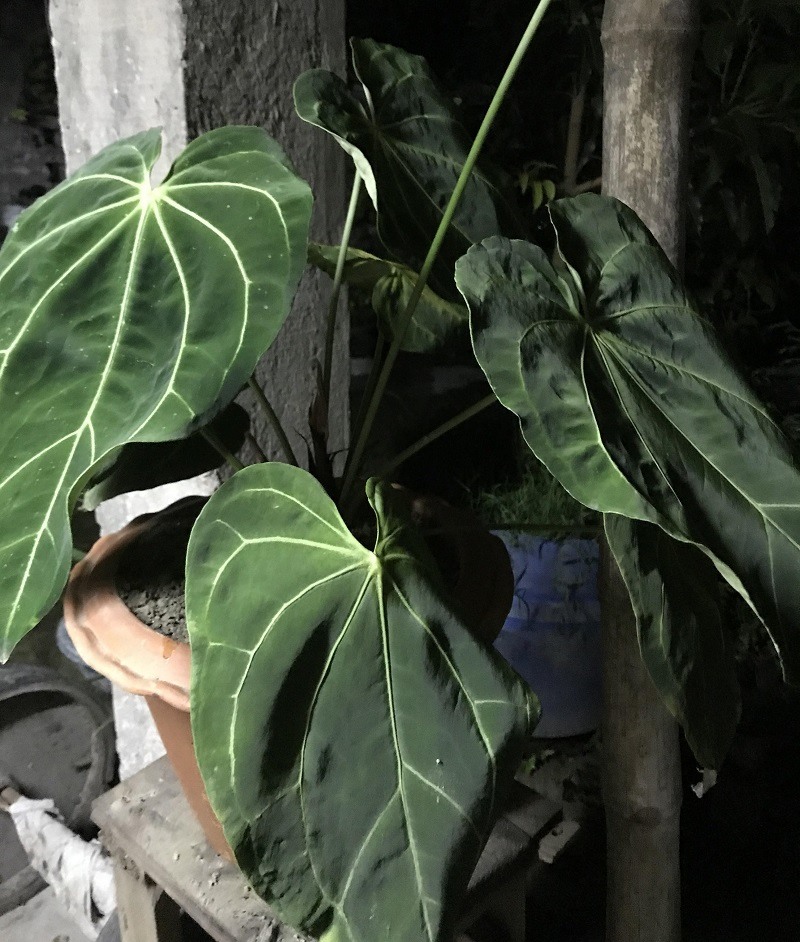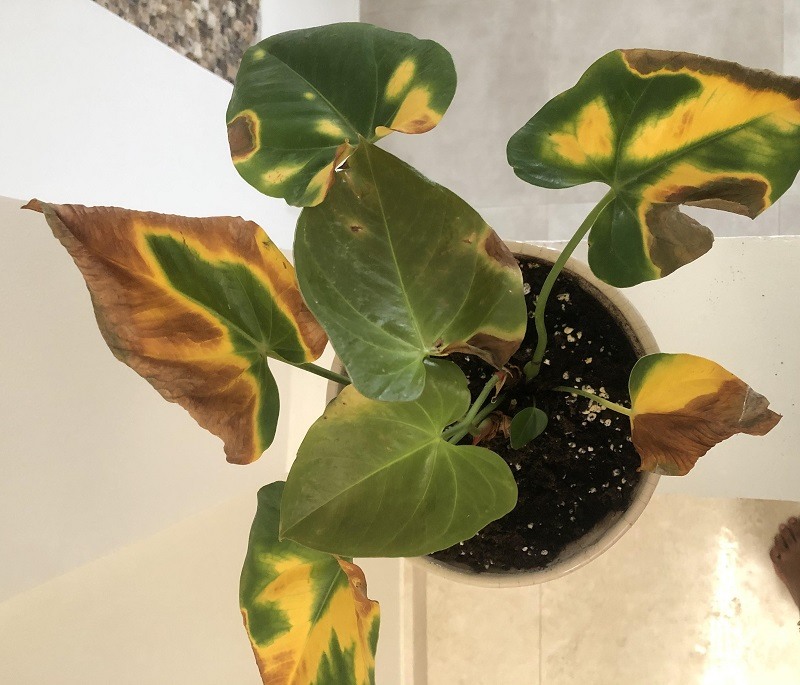Anthurium plant (flamingo flower) is a perfect choice for indoor and outdoor space. Thanks to its ability to tolerate various growing conditions and ease of care.
The beautiful heart-shaped flowers with dazzling colors symbolize hospitality. Besides that, these flowers inspire happiness and abundance in any space.
This guide provides in-depth anthurium plant care and other vital facts worth knowing about this beautiful houseplant. The anthurium care instructions are only applicable for indoor species.
How to Care for Anthuriums: Provide bright indirect sunlight, well-drainage potting soil, proper watering routine, temperature range of 65-85oF (18-30oC), 60% humidity level, and apply a slow-release fertilizer. Moderate resistance to pests and disease.
You May Also Like: Dendrobium Nobile Orchid Care

What Does Anthurium Look Like?
Anthurium (flamingo flower) is a hardy tropical plant grown indoors and outdoors in warmer climates. This perennial plant belongs to the Araceae family.
This houseplant is also known as flamingo flower, tail flower, and painted tongue plant. The indoor plant is native to Central and South America.
The beautiful heart-shaped flowers and glossy green foliages make this houseplant have a stunning appearance. It can thrive both indoor and outdoor to add aesthetic looks.
Anthuriums are climbers that grow up to 12-18-inches tall and spread up to 9-12-inches wide. I recommend pruning errant leaves or shoots that make the plant look off-balance.
Anthurium plants bloom throughout the year. The blooming varieties have distinctive heart-shaped waxy spathes and red or yellow tail-like spikes with deeply veined foliages.
The indoor plant comes in several varieties that get a lot of attention from houseplant enthusiasts. All anthurium varieties bring exotic tropical vibes to any space.
The high toxicity property to humans and pets is the leading drawback of anthurium plants. The toxicity level becomes worse after ingestion. So, take care of your toddlers and pets.
The flamingo flower can become fussy when certain care conditions are not met. But most anthurium care regimes are easy despite being a novice or experienced planter.
You May Also Read: How to Care for Mother of Thousands
Anthurium Care Details
| Origin | Colombia, Ecuador, Venezuelan. |
| Family | Araceae. |
| Scientific Name | Anthurium andraeanum. |
| Common Names | Flamingo Lily and Plainter Palette. |
| Type | Anthurium Scherzerianum. Anthurium Amnicola. Anthurium superbum. Anthurium hookeri. Anthurium Radicans. |
| Maximum Growth (Approx) | 18-inches tall. |
| Watering Needs | Once every 2-3 Days in a Hot Area. |
| Light Requirements | Need Medium to Bright Light to Bloom. |
| Humidity | An Average Humidity 80%. |
| Soil | Light and Loose Potting Soil with a pH of about 6.5. |
| Fertilizer | Once Every Three to Four Months with Higher Phosphorus Fertilizer. |
| Season | Bloom throughout the Year. Bloom Last for 2 to 3 months. |
| Temperature | 65-80oF (18-30oC). |
| Pests | Spider Mites, Mealybugs, Aphids, Thrips, and Scales. |
| Diseases | Bacterial Blight. Root Rot. |
How to Care for Anthurium Plants
Do Anthuriums Need a Lot of Water?
A proper watering routine is the leading anthurium care. The houseplant thrives in slightly moist potting soil and is never allowed to dry completely.
Most anthurium varieties utilize more water in summer. The season is where the plant experiences active growth and physiological activities. I recommend watering twice every week.
Be sure to reduce the watering frequency in winter since this indoor plant will use less water. It would be best to inspect soil moisture before watering to avoid overwatering issues.
Anthurium care outdoors involves watering every two to three days. The hot weather encourages higher water loss through the foliages and evaporation.
Here are tips to consider:
Use filtered or rainwater to water the flamingo flower. Allow tap water to sit overnight before watering the houseplant. It contains chemicals that might ruin the foliages and flowers.
- Water the houseplant early in the morning to encourage a proper hydration process.
- Soak the potting soil until excess water drain through the pot drainage holes.
- Always inspect the potting soil moisture level before watering.
Does Anthurium Need Direct Sunlight?
Anthuriums prefer medium to bright indirect sunlight to bloom. But this houseplant can endure low light conditions without becoming fussy.
Choose a spot in the house that receives medium to bright sunlight. Place the plant to receive natural light early morning or late evening. Harsh direct sunlight will hurt the houseplant.
However, low light conditions enhance slow growth and inhibit flowering. The more filtered light the plant receives, the more blooms are developed.
Here are tips to consider:
- Keep the indoor anthurium away from direct sunlight.
- Grow outdoor anthuriums under the shade.
- Allow the plant to enjoy early morning or late evening sunlight.
Does Anthurium Need Humid Condition?
Anthuriums are tropical plants that love warm and humid climate conditions. But flowering anthurium varieties can tolerate low humidity levels.
The average humidity requirement for anthuriums is about 60%. Maintaining this average humidity indoors is a daunting experience.
Install a digital hygrometer (Check Best Deals on Amazon) to help in monitoring the humidity changes. Install a humidifier to increase humidity when indoor humidity is less than 50%.
An alternative method is to group your anthurium with other indoor plants. It helps to slightly increase humidity around the plant.
Here are tips to consider:
- Mist the leaves more weekly.
- Wipe the leaves with a damp cloth daily.
- Use a room humidifier (Check Best Deals on Amazon).
- Use a plant saucer tray.

What Temperature Do Anthuriums Like?
Indoor anthuriums thrive under a temperature range of 65-85oF (18-30oC). But there is no need to worry as these plants can adapt and flourish in different household temperatures.
Freezing temperatures inhibit the plant from growing, and hot temperatures result in anthurium wilting. Ensure the indoor temperature does not fall below 50oF or go up to 90oF.
Be sure to keep the houseplant away from the heating source and air conditioning vents. These instruments may result in several anthurium plant problems.
Here are anthurium care indoor tips:
- Use a digital thermometer to monitor temperature changes.
- Maintain indoor temperature between 65 and 85 degrees Fahrenheit.
What Type of Soil Does Anthurium Need?
Anthurium plants prefer coarse and well-draining potting soil. Ensure the mix is slightly acidic (soil pH 5.5 to 6.0) to encourage healthy growth.
A perfect potting media for anthuriums should consist of the orchid mix, sand, and peat moss. These components tend to mimic their natural habitat.
Here are tips to consider:
- Change potting media if the plant experiences stunted growth.
- Potting soil failing to drain excess water through drainage holes
- Anthurium plants with root-bound issues need a transplant.
Does Anthurium Need Fertilizer?
A slow-release liquid fertilizer is ideal for anthurium varieties. But consider diluting the phosphorus-rich fertilizer before applying. The phosphorus nutrients encourage blooming.
The good news is that anthurium plants are not heavy feeders. But these tropical plants need nutrients and minerals to facilitate healthy growth.
I recommend applying fertilizer throughout the growing season (summer and spring). Most anthurium types are dormant in winter and fall. There is no need to applying fertilizer.
Do Anthuriums Need Pruning?
Pruning is vital for anthurium plants since it helps focus the energy on creating new leaves and flowers. Be sure to snip off old yellow and brown leaves.
Use a sharp and sterilized hand pruner to trim the old foliages or flowers. Pruning also helps to remove errant buds or leaves that make the plant look off-balance.
How to Propagate Anthuriums
Anthuriums are propagated through air root cuttings or stem cuttings. Propagation is ideal for anthuriums that have stopped blooming.
Cut the air root or select a stem about six inches long with a set of leaves and dip the cut end in a rooting hormone. Plant the air root or cut stem in fresh potting soil.
Water the potting media and place the plant in bright indirect sunlight. New growths will take about four to six weeks.
How to Repot Anthuriums
Anthuriums are vulnerable to root-bound issues. Repotting the houseplant every two years encourages healthy growth and flourishing.
Transfer the plant to a slightly larger pot not more than 2-inches. The new container chosen should be based on your watering habits.
Here are tips to consider:
- Remove the plant from the existing small pot.
- Remove the soil around the untangled roots gently.
- Grab a larger pot and fill with fresh potting mix halfway.
- Place the anthurium in the pot and fill it up with a potting mix.
- Water the houseplant and provide the required growing condition.
Do Anthurium Flower Every Year?
Yes. Anthurium produces new bloom after every three months. But you need to provide adequate natural light and ultimate care.
Anthuriums can live for many years and re-bloom throughout the period. Most anthurium varieties produce fewer flowers in winter or when grown under low light.
Here are tips to consider:
- Growth anthuriums on fertile and well-draining potting soil
- Use pots with bottom drainage holes to prevent overwatering.
- Ensure anthuriums get sufficient humidity.
- Place anthuriums in medium to bright indirect sunlight
- Use a dilute phosphorous-rich fertilizer to your anthuriums.
Common Anthurium Problems
Anthurium Pests
Most types of anthuriums are vulnerable to pest infestations. The common sap-sucking insects that attack anthuriums are spider mites, scales, thrips, mealybugs, and aphids.
Insect infestation occurs due to improper anthurium care routine. Flamingo flowers are grown under low light and a moist environment is susceptible to insect infestations.
Use horticultural insecticidal soap to eradicate the pests from the houseplant. Be sure to isolate the indoor plant to avoid the spreading of pests.
Anthurium Root Rot
Anthurium types love a slightly moist environment to flourish. Overwatering is the leading cause of anthurium root rot. It occurs due to poor soil drainage that inhibits aeration.
If you notice the base of your anthurium turning black and mushy, it is a sign of root rot. Consider repotting the houseplant to fresh potting soil with proper drainage.
Remember to trim the affected roots with a sterilized pruner. Ensure the container has some drainage holes at the bottom to get rid of excess water.
Anthurium Brown Tips
The issue occurs due to direct sunlight exposure and low humidity. Direct sunlight causes dry brown patches on the leaves, and low humidity results in brown tips.
Relocate the current position of the houseplant and increase the humidity level. It will help to alleviate the anthurium leaf problems.
Anthurium Leaves Losing Their Shine
If your flamingo flower is losing its shine, it could be due to low humidity. Anthuriums prefer warm and humid environments to flourish.
Consider misting the leaves weekly or install a humidifier to boost the humidity level. It creates an environment that mimics their natural habitat.
Anthurium Leaves Turning Brown
Anthurium leaves turning brown occur due to direct sunlight, low humidity, over-fertilization, improper watering routine, and more.
I recommend fixing all underlying issues to keep the plant healthy. If the condition persists for weeks, the plant is likely to die.
Anthurium Leaves Turning Yellow
Overwatering is the leading cause of anthurium leaves turning yellow. Anthuriums do not thrive in a damp environment due to root rot issues.
Inconsistent watering habits can also result in anthurium leaves turning yellow. I recommend soaking the potting soil until the excess water passes through the drainage holes.
Anthurium Not Growing
Anthurium varieties stop growing during winter. The season forces the plant to enter the dormancy stage and utilize fewer nutrients.
Rapid and vegetative growth occurs in warm spring. Be sure to provide medium to bright sunlight to enhance the fast growth rate.

Is Anthurium Poisonous to Pets and Humans?
All anthurium types contain calcium oxalate crystals which are toxic to people, cats, and dogs. The toxicity level becomes worse when the plant is ingested. Keep this houseplant away from your toddlers and pets.
Final Word
Anthuriums are the best option for beginners looking for an easy houseplant to grow. The indoor plant does not need special requirements.
Most anthurium species can tolerate harsh growing conditions for a couple of days without becoming fussy. Use proper drainage potting media and a pot with drainage holes.
Ensure the houseplant gets sufficient natural sunlight, high humidity, and a slightly moist environment. These ultimate anthurium care routines will enhance better growth.
